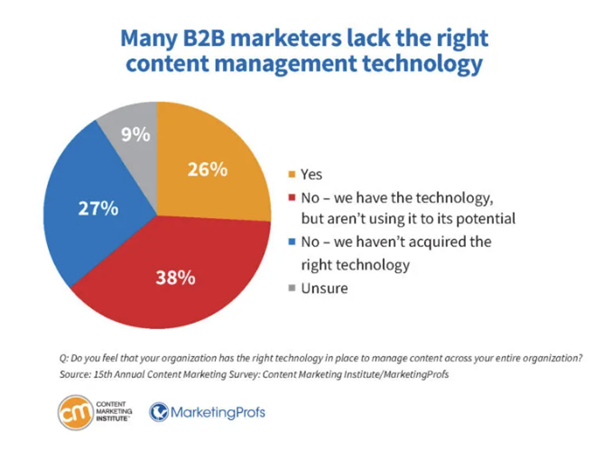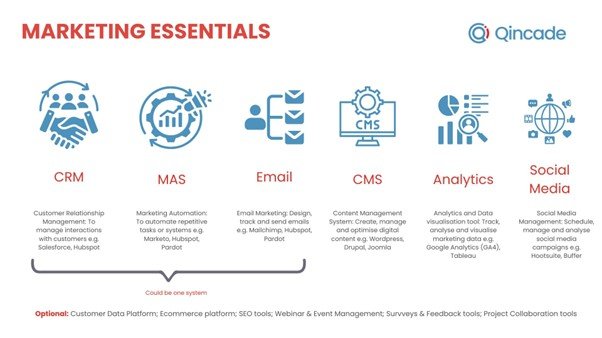When a biotech CMO recently told us, “We’ve invested in three different platforms over the last two and a half years, and none of them talk to each other,” it reminded me of a recurring issue that is common across our industry: marketers either lack the right technology, or they’re sitting on tools that no one knows how to use effectively.
A recent survey found that only 26% of B2B marketers believe their organizations have the right technology to manage content across the business. Worse still, 38% admit that they own the tools but don’t use them to their fullest potential [1]. It’s a troubling pattern, especially in science-driven sectors where marketing already faces unique challenges like complex buyer journeys, regulatory oversight, and multi-stakeholder sales cycles.

So, why is this happening, and how do we fix it?
The roots of the problem
- Buying before planning
One senior marketer I recently spoke to confirmed what I’ve observed too – namely, that many teams skip the most critical first step: measurement planning. Without a clear framework for what will be measured and why (which markers matter most to your business), even the most sophisticated analytics tools become little more than expensive dashboards. We recommend starting with mapping the buyer’s journey through to technology alignment. This will help to avoid stacking mismatched platforms that don’t solve the real problems and don’t deliver actionable insights. - Too many tools, not enough people
The real gap often isn’t the technology itself, but the in-house knowledge required to manage and interpret it. Speaking from experience, it is often the case that in a large marketing team of, say, 20 individuals, who all have distinct skill sets, typically only between 1-3 people (as a best-case scenario) would have the depth of knowledge and the daily familiarity with each tool. On average, according to a recent survey, teams juggle ca. 35 martech tools – each with its own data format, language, dashboards, APIs and outputs. This leads to duplicates, incomplete or dirty data, fragmented experiences, inefficient campaigns and costly staff frustration. [3] Consolidation of tools helps to lower the noise, but be careful to make sure you don’t sacrifice essential features. It is also true that in Life Sciences companies, budget approvals are easier for platforms than for headcount, which ultimately results in over tooled and under (wo)manned teams. - Silos everywhere
It’s one thing to have tools; it’s another for them to talk to each other, and for the various internal teams to talk to one another too. A senior marketer at AWS described exactly the impact of this data fragmentation challenge: “The proliferation of digital channels means organizations often struggle to consolidate and make sense of the vast amounts of data generated”. In Biotech and Life Sciences firms where commercial, medical affairs, and regulatory teams often use different systems, this challenge is magnified. To pull everything together takes an enormous amount of internal workshopping time and consistent efforts to help bring about cross-team alignment. - Inconsistent brand experiences
Now, let’s consider how inconsistent brand stories across channels erode trust: prospects see one message on social, another in sales decks, and yet another in email. Does that seem familiar? This inconsistency often stems from not having a single source of truth, like a proper DAM (digital asset management system). - No culture of improvement
Even after investing in powerful marketing tools and software, many teams don’t iterate. There is great power in accepting that a cycle of continuous improvement is required: audit one tool monthly, review the stack quarterly, and realign strategically every year. Marketing leaders, you may wish to assign a person in your team who has the greatest familiarity with a particular platform to be that auditor and go-to expert.
What the right marketing tech stack looks like
The essentials are not mysterious. For a science-led SME, a functional marketing stack usually includes:
- A CRM to manage interactions with customers and partners (e.g., Salesforce, HubSpot)
- A MAS (Marketing Automation System) to take repetitive workflows off the team’s plate (e.g., Marketo, Pardot)
- Email marketing tools for campaign design, tracking, and reporting (e.g., Mailchimp, HubSpot)
- A CMS to manage and optimize digital content (e.g., WordPress, Drupal, Joomla)
- Analytics to track performance and visualize insights (e.g., Google Analytics GA4, Tableau)
- Social media management tools to schedule and analyze campaigns (e.g., Hootsuite, Buffer)
Optional but often valuable additions include customer data platforms, SEO tools, webinar/event platforms, and collaboration tools.

The real challenge is ensuring these tools actually work together. For smaller Biotech and Life Science firms, that often means aiming for as much integration as possible, ideally within one system or a tightly connected set of systems. Otherwise, teams end up spending more time reconciling data than driving strategy.
Lessons from the trenches
I once worked within a diagnostics company that had six different repositories for content: Dropbox, SharePoint, a CRM, Google Drive and a pair of local servers. It took the marketing ops lead an hour to track down the latest approved white paper. After a painful and time-consuming audit lasting several months, an investment into a real DAM was made, which was integrated with a project management system. Within six months, review cycles were cut by 40% and finally, it felt like there was a reliable “single source of truth” for content assets.
Marketing leaders, consider solving the reporting chaos by creating a cross-functional analytics council. Instead of marketing owning one set of dashboards and sales another, align on the common KPIs tied to business objectives, and build dashboards for those. This will transform the way you have internal conversations about present, past and future sales and marketing activities.
Practical fixes for the most common issues
- Start with strategy, not software: Map business goals and customer journeys first. Then choose tools to support them (not the other way around).
- Audit what you already own: Most teams underutilize what’s already in the stack. A quarterly tools audit can reveal redundancies and quick wins, so it’s always a great idea to start there and think about any training that might be required to upskill your team to make the best use of what you already have.
- Integrate early: Select tools that integrate seamlessly with each other and train your team for integrated use.
- Invest in people and training: Whether it’s a GA4 specialist or a content workflow manager, skill gaps cost more than license fees in the long run.
- Centralize brand assets: A DAM integrated with your broader stack ensures everyone is working from the same playbook.
- Simplify analytics: Define a consistent reporting language and tie KPIs directly to objectives. Don’t measure everything, only what truly matters.
- Use AI strategically: AI should be your copilot, not a random collection of point solutions. Establish organization-wide guidelines before adopting. Many martech stack tools already have AI agents built in, so make sure you know how to use them for impact.
Moving forward
Technology doesn’t solve Life Science marketing challenges on its own. What sets apart the companies that get it right is not the size of their stack, but the clarity of their strategy, the discipline in how they use the tools, and the investment in people who can bridge crunching marketing data with building strategy. Leadership is critical to creating the right environment for marketing teams to utilise their tech stacks as fully as possible.
If you feel like you’re drowning in unused platforms or chasing shiny new features, you’re not alone. The good news is that with the proper adjustments, even a modest stack can deliver measurable impact and unlock your marketing momentum. The question isn’t whether you have the right technology; it is really about whether you’re using it in the right way.
If you’re still not sure where to start, drop us a message at Qincade (hello@qincade.com) and we’ll be happy to chat with you about your tech stack challenges and advise on integrations that can best support a revenue-generating content marketing engine that works for your business.
References
[1] B2B Content Marketing Benchmarks, Budgets, and Trends: Outlook for 2025 [Research]





